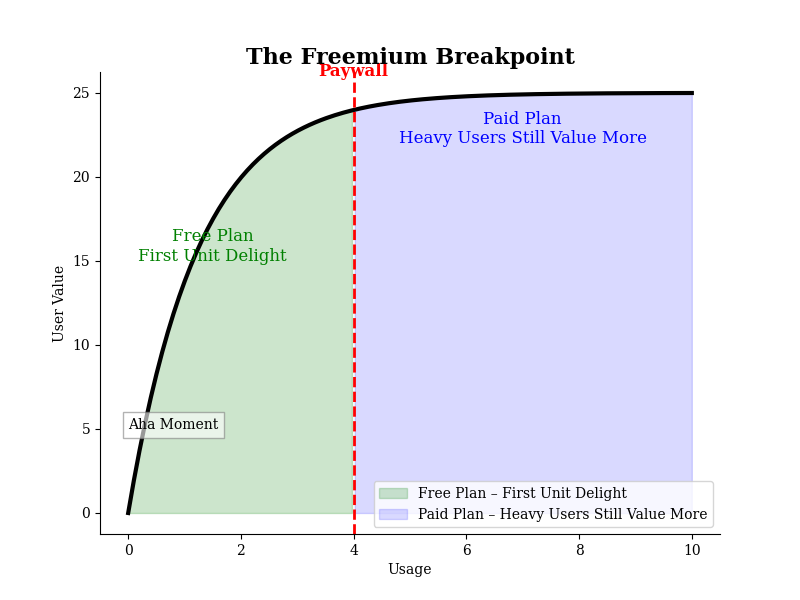Thesis: Freemium works when the free plan delivers the first unit of value — the steep part of the curve where users get hooked. The paywall should sit just before utility starts to flatten for heavy users. That is where people are most willing to pay for the next unit.
Why Economics Matters
Economists like Jevons and Marshall argued that the first unit of consumption brings the most satisfaction. Each additional unit adds less. This is diminishing marginal utility. In software, the first meeting, the first shared file, or the first message carries huge value. After that, utility still rises, but more slowly. Casual users are satisfied and stop. Heavy users keep going.
Hal Varian and Paul Belleflamme described how “versioning” lets companies offer different versions of the same good. This is second-degree price discrimination: users self-select. Casual users stay on the free plan. Power users choose the paid plan, because the next unit of usage still matters to them.
Behavioral economics also supports this. The “endowment effect” says people value something more once they own it. When users build a file library in Dropbox or a message history in Slack, they value it more. The free plan creates ownership. The paywall protects that ownership by charging for more.
Academic work shows freemium can maximize profits if the free plan sparks adoption and the paywall captures heavy users at the right breakpoint. Place the gate too early and you choke growth. Place it too late and you give away your best users.
Four Steps to Get It Right
1. Find the breakpoint.
Use data, not intuition. Look at how retention changes with usage. The point where engagement curves bend upward is your breakpoint. For Zoom, that was the 40-minute mark. Casual users were fine with short calls. But for sales teams and teachers, the 41st minute had very high marginal value. They upgraded.

2. Use one clean lever.
Pick time, quantity, or quality. Do not mix too many. Slack chose quantity and time. On the free plan, you get only 90 days of message history. Small groups survive on that. But larger teams value continuity. The marginal utility of the “91st day” is high, so they pay. The lever is simple, obvious, and effective.
3. Delight first, pressure later.
The free plan must make the first job rewarding. That means users reach their “aha” moment fast. Dropbox did this well. Syncing the first file was effortless and free. That created delight. But as users added photos, videos, and shared folders, the marginal utility of more storage grew. That pressure drove upgrades. The pattern is clear: delight on the first task, pressure at the breakpoint.
4. Test and adjust.
Do not assume you know the right limit. Treat your paywall as an experiment. Move it, measure, and refine. For example, communication apps that tested different caps on collaboration found that loosening the cap increased viral invites but reduced conversion. They had to shift the limit to balance growth and monetization. Economics calls this “equilibrium.” You are balancing network effects, marginal utility, and price discrimination in one system.
Common Mistakes
Some startups cut the free plan too early. That kills adoption and word-of-mouth. Others give away too much. That satisfies heavy users forever and stalls revenue. The fix is to place the paywall where the next unit is still highly valuable for power users, while casuals are already satisfied.
Bottom Line
Freemium is not a gamble. It is applied economics. The free plan delivers first-unit delight. The paywall captures demand at the breakpoint, where heavy users still feel the utility of more. By finding that point, picking the right lever, delighting first, and testing relentlessly, you can design freemium models that both grow and monetize.
References
- Alfred Marshall, Principles of Economics. https://www.marxists.org/reference/subject/economics/marshall/bk3ch03.htm
- William Stanley Jevons, The Theory of Political Economy. https://oll.libertyfund.org/titles/jevons-the-theory-of-political-economy
- Hal R. Varian, “Versioning Information Goods.” https://people.ischool.berkeley.edu/~hal/Papers/version.pdf
- Paul Belleflamme, “Versioning in the Information Economy.” https://perso.uclouvain.be/paul.belleflamme/papers/CESifo2006.pdf
- Vineet Kumar, “Making Freemium Work.” Harvard Business Review (2014). https://hbr.org/2014/05/making-freemium-work
- Z. Shi, “Freemium as an Optimal Strategy for Market Dominant Firms.” Marketing Science (2019). https://pubsonline.informs.org/doi/10.1287/mksc.2018.1109
- Y. Deng et al., “Spillover Effects and Freemium Strategy in the Mobile App Market.” Management Science (2023). https://pubsonline.informs.org/doi/abs/10.1287/mnsc.2022.4619
- Zoom pricing. https://zoom.us/pricing
- Slack pricing. https://slack.com/pricing
- Dropbox HBS case. https://hbsp.harvard.edu/product/811065-PDF-ENG
